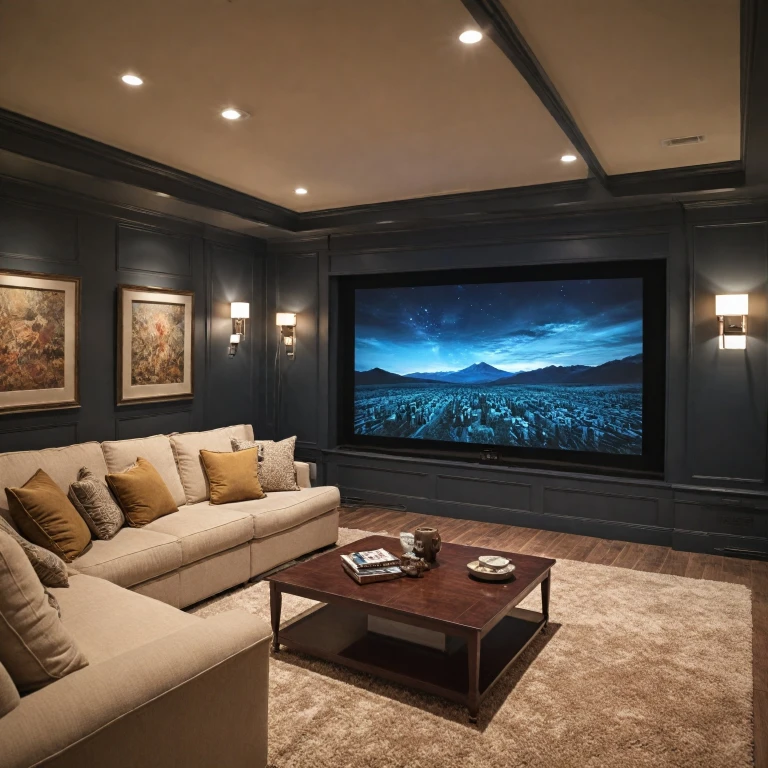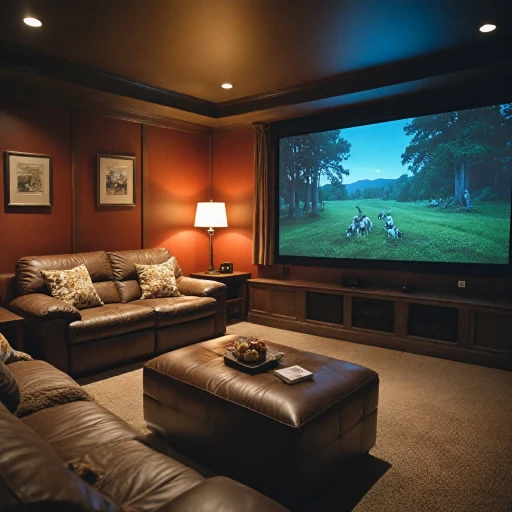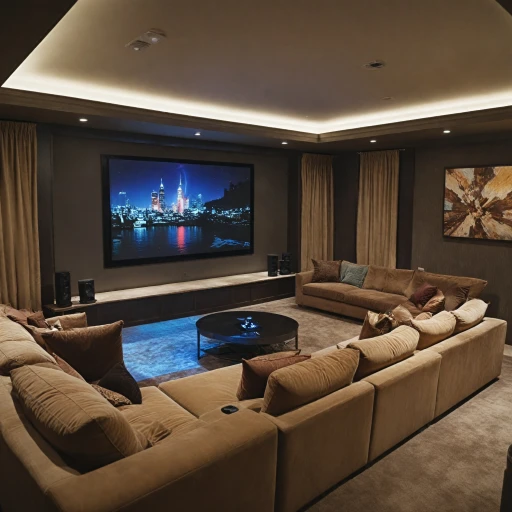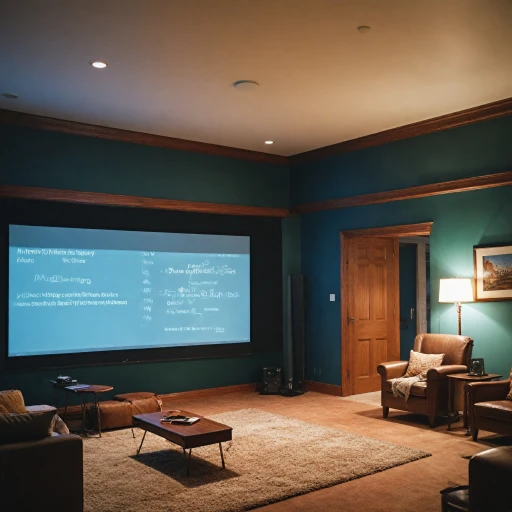What is a Long Throw Projector?
Delving into Projector Throw Distances
When setting up a home theater, understanding the concept of throw distance can greatly influence your experience. The type of projector you choose, such as a long throw projector, plays a crucial role in defining how far the device needs to be positioned from the screen to achieve the best image size and clarity.
A "throw" refers to the distance over which a projector can display an image. Long throw projectors are designed for larger spaces and require a longer distance between the projector and the screen to produce a high-quality image. This is especially important if you're aiming for an expansive screen size, where short throw projectors might fall short.
Defining Characteristics of Long Throw Projectors
Long throw projectors typically exhibit a throw ratio that means positioning them further away from the screen than their short throw counterparts. This type of projector is ideal for creating a cinema-like experience in a spacious room. They generally offer a higher brightness, measured in lumens, ensuring the image remains vivid even across large distances.
For example, models like the Epson PowerLite white laser series boast impressive image quality, thanks to their powerful resolution and brightness features. These projectors excel in rooms with ample space, allowing for optimal projector screen sizes without compromising the picture quality.
Moreover, the flexibility of placement is another advantage; with the correct installation, you can easily adjust the projector alignment, enhancing the image quality and providing a spectacular viewing experience. From selecting the right projector to imagining the perfect room setup, the choice between long and short throw projectors significantly impacts the projection outcome and overall satisfaction in a home theater setting.
In upcoming sections, we will explore specific advantages, provide practical installation tips, and delve into how long throw models compare with short throw counterparts to aid in making an informed decision.
Advantages of Using a Long Throw Projector
Exploring the Edge: Triumphs of Long Throw Projectors
Long throw projectors bring a remarkable set of advantages to the home theater scene, and understanding these can significantly enhance your viewing experience.
One major advantage is the flexibility in installation. Long throw projectors can project their image over an extended distance, making them ideal for larger rooms where space is not a constraint. Unlike short throw models that need to be placed very close to the projector screen, long throw projectors offer the convenience of placing them out of the way, either in the back of your theater room or mounted on the ceiling.
Because long throw projectors are typically mounted at a distance, they can cast a very large image with excellent clarity. This is beneficial when setting up a home theater where the goal is to create an immersive experience that rivals the cinema. The top projector models, like the Epson Powerlite series, boast high lumens and superior resolution to ensure image quality remains sharp, even at large screen sizes.
Another benefit of long throw projectors is their compatibility with bigger screens, enhancing the grandeur of the theater experience. While ultra short throw or short throw models can result in limited screen size options, a long throw projector can take advantage of much larger surfaces, creating a more engaging and cinematic feel.
In terms of technology, today's long throw projectors are equipped with various features like laser engines and modern throw ratio settings. These advancements provide an excellent balance of brightness and color fidelity. Laser projectors, in particular, stand out for their longevity and energy efficiency, offering low-maintenance operation and brilliant images that bring home theater content to life.
In conclusion, for rooms with ample space, long throw projectors can be an outstanding choice, offering flexibility in installation, larger-than-life images, and advanced technological features that significantly enhance the viewing experience.
Installation Tips for Long Throw Projectors
Optimizing Placement for Maximum Visual Experience
When considering long throw projectors, optimizing the placement is crucial to maximize your home theater experience. Ensuring the precise throw distance not only impacts image quality but also influences the overall ambiance of your room. Here are some installation tips to help you set up your long throw projector for the best results:
- Room Size and Layout: A larger room is ideal for long throw projectors. This allows sufficient space between the projector and the screen, ensuring the expansive image you desire. Consider the dimensions and seating arrangement of your room to position the projector at the optimal distance.
- Determining Throw Distance and Ratio: The 'throw ratio' is a key factor. It tells you the distance the projector needs to be from the screen to produce a specific image size. Different projector models, like those from Epson or other brands, have varying throw ratios which should align with your screen size for crisp visuals. Checkout those details on Amazon or the manufacturer's website.
- Mounting Options: Ceiling mounts can offer a neat and unobtrusive setup for projectors like the Epson PowerLite. These mounts help achieve the correct angle and distance more effectively than a tabletop setup. Balancing between the brightness and the resolution of your projector will further ensure immersive visuals.
- Screen Considerations: Choose a projector screen that complements your projector's capability. A white screen often enhances brightness, especially in a powerLite white laser setup. However, a gray or black screen can offer better contrast and deep image quality in darker room settings.
- Controlling Ambient Light: Consider the room's lighting conditions. Minimizing ambient light enhances brightness and resolution, reducing the impact of potential room brightness on your screen view. A black laser screen can also aid in managing reflections.
- Distance Calibration: Take your time to experiment with the throw distance to find the sweet spot that fills your screen perfectly without compromising on sharpness. Adjusting settings like lumens and brightness may also optimize the final projection.
For further considerations on getting the most out of your projector system, including preparing some delicious popcorn for your home theater, check this
resource on popcorn preparation.
Image Quality Considerations
Enhancing Clarity and Vividness with High-Quality Projections
When selecting a long throw projector for your home theater, image quality is paramount. This encompasses several factors that collectively contribute to the overall viewing experience:
- Throw Ratio: A vital metric, the throw ratio, helps determine how far your projector needs to be from the screen to achieve the desired image size. Long throw projectors typically boast a higher throw ratio than their short throw counterparts, catering to larger rooms and screens.
- Resolution: Higher resolution means sharper, more detailed images. For the best experience, opt for a projector with at least 1080p Full HD resolution. For those looking to future-proof their setup, 4K options are available but usually come with a higher price tag.
- Brightness and Lumens: Understanding the brightness of a projector is essential, especially in ensuring your projected image remains visible and vibrant even in well-lit rooms. Long throw projectors like the Epson PowerLite series offer impressive lumens in brightness, making them suitable for varied lighting conditions.
- Color Accuracy and Contrast Ratio: Color reproduction and contrast ratio are critical for vivid, true-to-life images. Projector models using laser technology often have superior color accuracy.
- Room Considerations: The room’s color scheme, wall reflectivity, and ambient lighting all influence image quality. Ideally, the projector should be paired with a black or grey projector screen to enhance contrast, especially in darker scenes.
These considerations underscore the importance of configuring your long throw projector to optimize image quality, achieving a cinema-like experience tailored to your home theater environment.
Comparing Long Throw and Short Throw Projectors
Deciphering Long Throw Versus Short Throw for Optimal Viewing
When diving into the world of home theater projectors, the choice between long throw and short throw projectors can be pivotal. Each type comes with its own set of benefits, tailored to meet specific needs and setups.
Throw Distance and Room Size
The primary distinction lies in the throw distance, which impacts how far from the screen the projector needs to be placed. Long throw projectors generally work best in larger rooms that accommodate a greater throw distance. This is ideal if you're setting up a theater in a generously sized space, allowing the projector to sit further back.
Short throw projectors, however, are a game-changer in smaller spaces. By positioning them closer to the screen, they can create comparably large images without the extensive distance required for long throw projectors. This flexibility proves invaluable in compact rooms.
Image Size and Quality
The throw distance heavily influences the effective screen size. Long throw projectors excel when a large image is desired, but only if the room can support this with its size. By contrast, short throw projectors, especially ultra-short ones, project large images from close proximities, maintaining a high image quality thanks to advances in lens and laser technologies.
With notable brands like Epson providing models that cater to both needs, including epson powerlite, understanding various projector specifications like throw ratio is crucial. If achieving the best resolution and brightness is your aim, then examining the balance between distance and image quality becomes critical. Lumens also play into this equation; more lumens can help combat ambient light, ensuring crisp, vibrant colors regardless of the throw distance.
Installation Considerations
For those considering long throw, installation typically involves ceiling mounting. It's essential to account for the appropriate throw distance to achieve the desired screen size. Equip yourself with a white laser or black laser projector depending on the room's light conditions for better image fidelity.
Conversely, short throw projectors offer placement versatility. They can be placed on a shelf or stand close to the screen, simplifying installation and potentially reducing costs on mounts or extensive cabling.
In summary, while both long and short throw projectors have their unique strengths, the choice largely depends on your room's dynamics and theater needs. Every projection setup should consider tailored elements like the throw ratio and brightness to offer the best viewing experience.
Common Challenges and Solutions
Potential Obstacles and Solutions
When setting up a home theater with a long throw projector, certain challenges often arise. Addressing these effectively can enhance your viewing experience.
- Room Space: Long throw projectors require more distance. Unlike short throw models that can project large images from limited spaces, long throw ones need larger areas. Ensure your room's dimensions can accommodate the necessary throw distance for achieving optimal image size.
- Brightness Levels: Ensuring adequate brightness is crucial. Projects with high lumen ratings, such as Epson PowerLite, are recommended if your room has ambient light. The throw ratio influences the screen's lit-up area, impacting brightness.
- Installation Complexity: Aligning the projector perfectly can be challenging. Ceiling mounts or specific furniture support might be required to position your projector adequately. Use adjustable mounts to fine-tune the projector's placement relative to the screen.
- Image Quality: Achieving vivid resolution depends on several factors, including the projector model and lamp type. Black and white laser projectors often provide excellent clarity. Consider factors like wall color, opting for epson black screens or white projector screens to enhance image contrast.
- Screen Size Limitations: A long throw projector allows flexibility in screen size, but ensure you verify your projector's capacity to support the desired dimensions without compromising resolution quality. Larger screens require higher resolution projectors to maintain clarity.
Navigating these challenges calls for a careful selection of projector specifications and strategic setup considerations. Overcoming these typical hurdles with well-informed decisions ensures that you make the best use of your long throw projector, transforming your room into a captivating theater environment.




